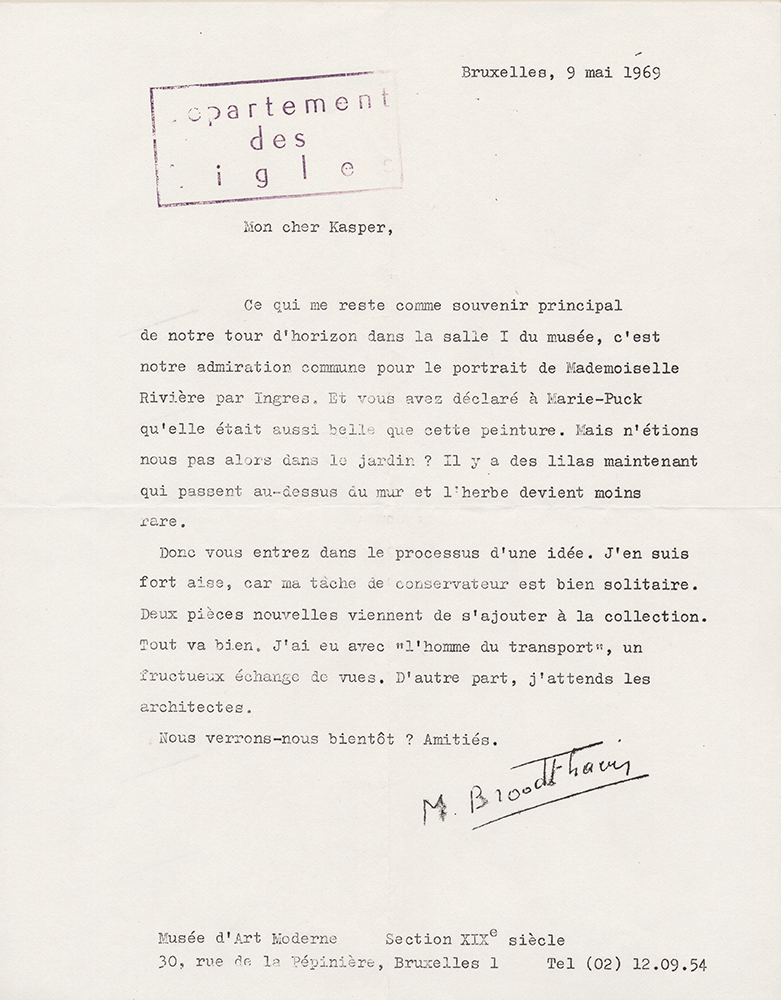

An Open Letter of dubious authenticity
In relation to a recent New York Times story about a prized Galileo draft letter at the University of Michigan that is now considered a forgery, here is a similar but more modest example in our case. Four years ago we acquired a lone Open Letter by Marcel Broodthaers, one of our favorites, his "MUSEUM" letter with "a rectangular director, a round assistant, a triangular cashier, a square security guard." We had a glimmer of doubt about its authenticity but had no way of really knowing without a comparison. We do recall having been warned that the dealer we purchased it from had a dubious reputation.
Now that we have acquired the same letter in a cache of ten from the highly reputable Sims Reed Rare Book Dealers in London, we see many indications that our first letter is a forgery.
For one the paper is different, lighter, more transparent. That's easy to notice, but we assume the forger would have been smart enough to at least buy a stock of period paper, even if it wasn't exactly the same stock. It could also be that the letter is authentic but hors commerce, an extra copy that got made as a test or backup copy but was never sent.
Just as important, compared to the new arrival the first acquisition feels barely handled — odd for an object that should have been run through a mimeograph machine, folded twice, inserted into an envelope, jostled through the mail, delivered, and then handled, opened, and removed from said envelope by its recipient.
Last, and most crucially, the first letter has never been folded and lacks the signature "half, and half again" creases that all ten of the new acquisitions have. We'll never really know until we hire an expert; we're amateurs at this.
One last point of interest is that if the first letter is a forgery, the forger must have at least had an authentic copy to work from and a period typewriter, likely an IBM Selectric, to execute the forgery with. When you lay the first letter on top of the second letter and place them on a light table, the position of the typed words on the page of the first letter align perfectly with those of the second.
So how many copies did the forger make from their original and shill out into the world? Another question for the experts. For now we're kind of happy to have one. Allegedly.
Informed opinions about this are welcome, we'd love to hear from you.
Now that we have acquired the same letter in a cache of ten from the highly reputable Sims Reed Rare Book Dealers in London, we see many indications that our first letter is a forgery.
For one the paper is different, lighter, more transparent. That's easy to notice, but we assume the forger would have been smart enough to at least buy a stock of period paper, even if it wasn't exactly the same stock. It could also be that the letter is authentic but hors commerce, an extra copy that got made as a test or backup copy but was never sent.
Just as important, compared to the new arrival the first acquisition feels barely handled — odd for an object that should have been run through a mimeograph machine, folded twice, inserted into an envelope, jostled through the mail, delivered, and then handled, opened, and removed from said envelope by its recipient.
Last, and most crucially, the first letter has never been folded and lacks the signature "half, and half again" creases that all ten of the new acquisitions have. We'll never really know until we hire an expert; we're amateurs at this.
One last point of interest is that if the first letter is a forgery, the forger must have at least had an authentic copy to work from and a period typewriter, likely an IBM Selectric, to execute the forgery with. When you lay the first letter on top of the second letter and place them on a light table, the position of the typed words on the page of the first letter align perfectly with those of the second.
So how many copies did the forger make from their original and shill out into the world? Another question for the experts. For now we're kind of happy to have one. Allegedly.
Informed opinions about this are welcome, we'd love to hear from you.